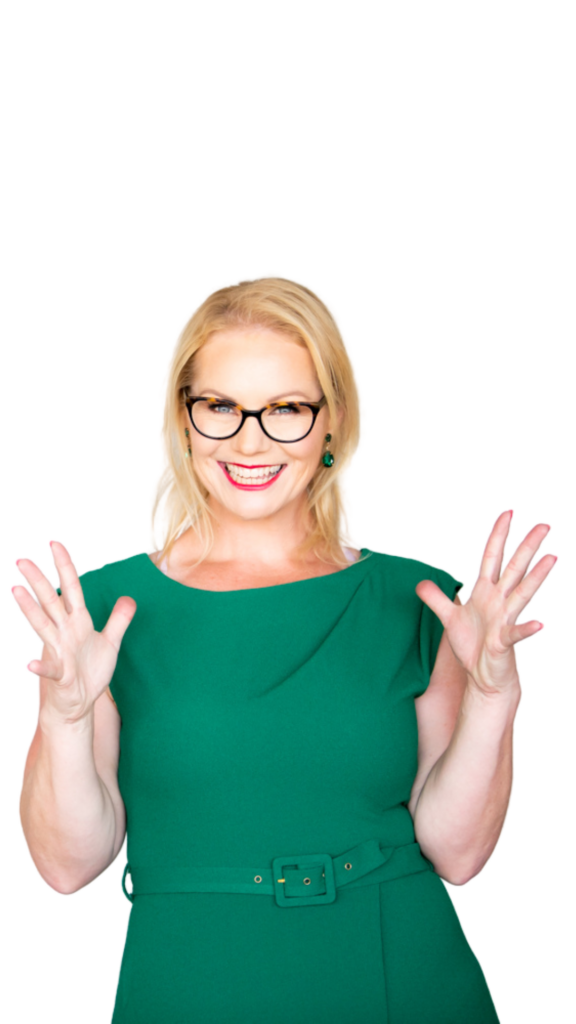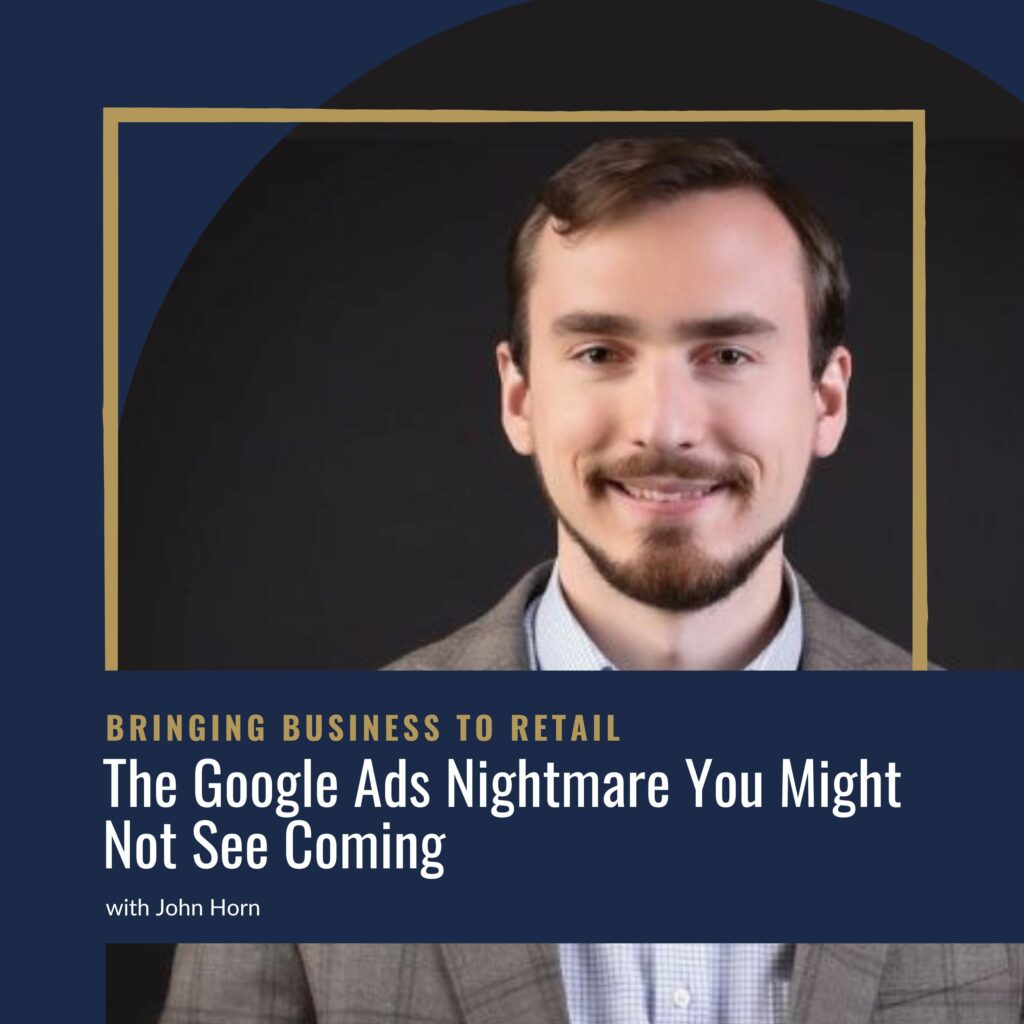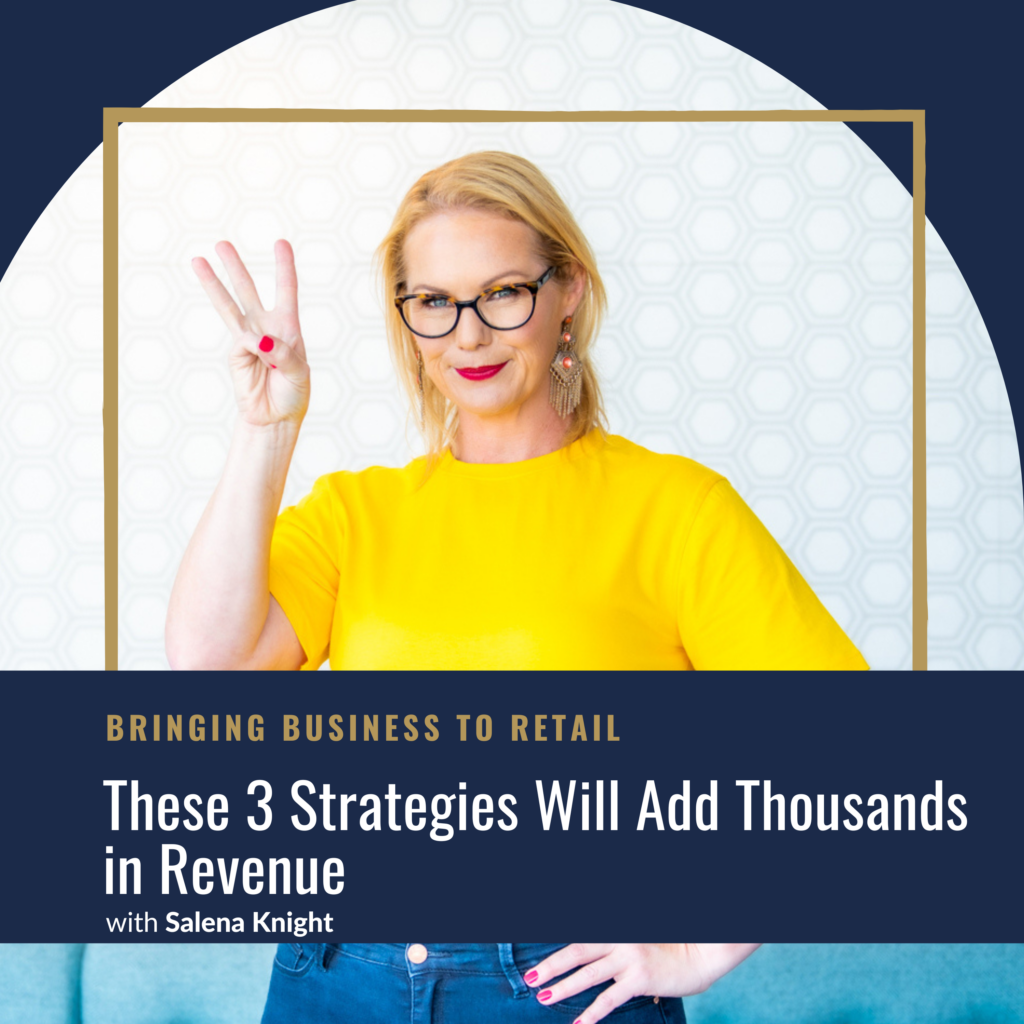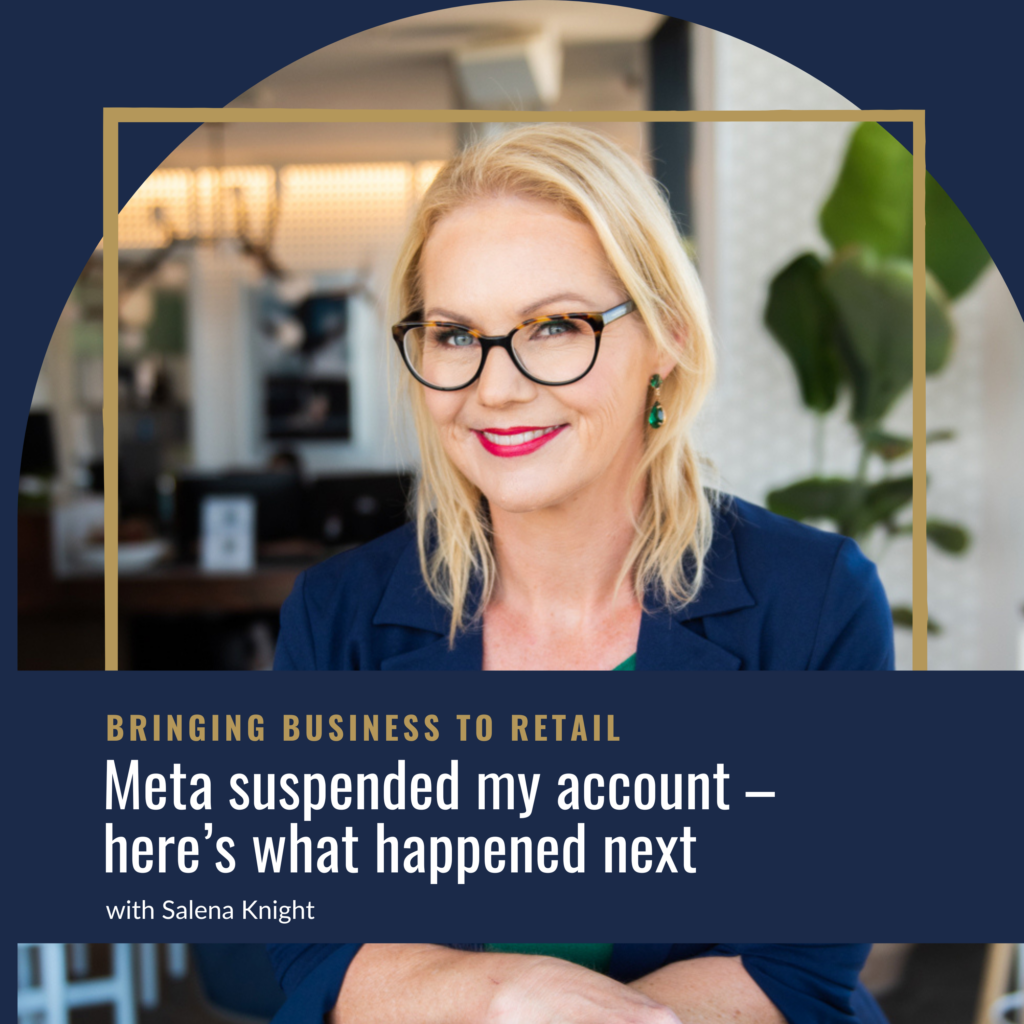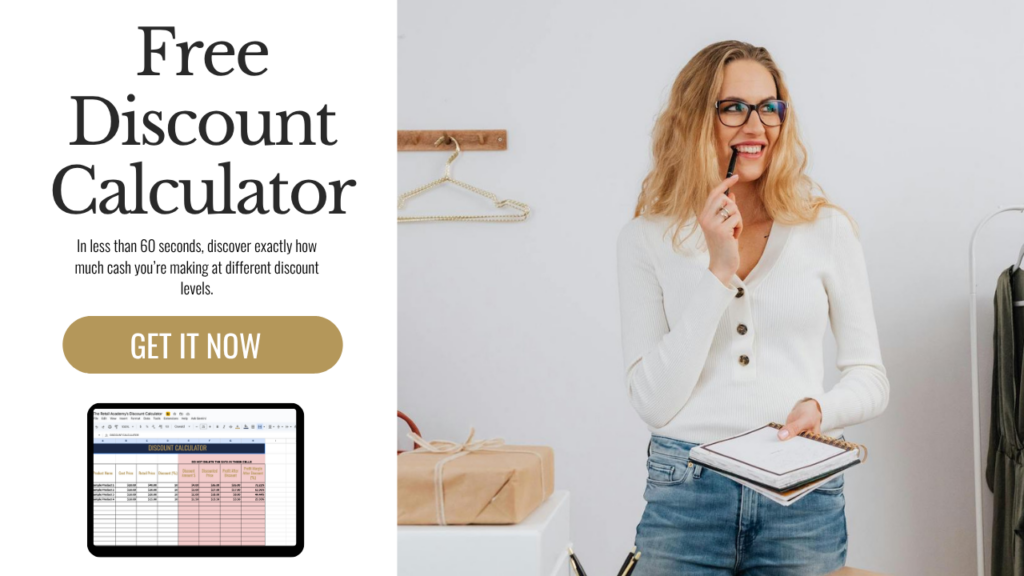
My coconut body wash does more than make me feel like I’m going on holiday.
It also showcases a number of ways that business owners could be increasing their profits.
That seems like a lot to get from a $25 bottle of body wash, but trust me, it’s just the start (and yes, it really is a vacation in a bottle). It’s seen me through a lot, including something I’ve personally struggled with and had to overcame to make my business boom.
Listen to this week’s podcast as I discuss the 7 things that a business owner can do to increase their profits without losing customers. (You could be doing some of them RIGHT NOW!)
LISTEN NOW on The Bringing Business To Retail Podcast
Body wash preferences and shopping habits. 0:02
Negotiating with suppliers for better deals to increase profits. 3:21
Pricing strategies for retailers, including cost analysis and value-based pricing. 8:11
Pricing based on product value, customer service, and competitors. 13:18
Catering to different customer segments with varying price points. 18:43
Strategies to increase profitability for businesses, including pricing tactics and product mix optimization. 22:40
Pricing strategies for e-commerce businesses. 28:15
Podcast with Dean Salakas: Scaling A Family Business Into Australia's Biggest Party Store
Salena Knight 0:02
Hey there, and welcome to the bringing business to retail podcast. If you're looking to get more sales, more customers, master your marketing, and ultimately take control of your retail or E commerce business, then you're in the right place. I'm Celina Knight, a retail growth strategist and multi award winning store owner whose superpower is uncovering exactly what your business requires. To move to the next level. I'll provide you with the strategies, the tools, and the insight you need to scale your store. All you need to do is take action, ready to get started.
Salena Knight 0:51
Hey there, and welcome to today's episode of the brainy business to retail podcast. I'm your host Selena night. And I am so grateful for you to give me a little bit of time in your day to learn to grow to be inspired and to hopefully take action in your business. Now, I was at the grocery store a couple of days ago, and I had run out of body wash. Now, fun fact about me, I'm a tight boss, I don't like to spend money if I don't have to on things that I don't value, I guess is the right I'm happy to spend money on things that I value. But I kind of you know, like everyone I kind of have a limit. I generally buy my body wash when it is on special, because quite often it is 40 or 50% off. And it's like $25 A bottle. And I'm sorry, but I'm not paying $25 for a bottle of body wash. So if you will, that's not me, that's not the thing that I value spending my money on. But I do like this specific body wash, it is great for my skin. I love the smell of it. And every time I use it, it kind of makes me feel like I'm on holidays because it's got coconut in it. And so I've been using the same one for ages. And like I said I usually program in to buy it when it's on special. But when I was at a supermarket a few days ago, I had been out of this body wash for a few days already. And I've been using Ed's body wash now, not to say that he doesn't use a very masculine one he just uses I think it's dove. Yeah, not what I'm looking for in my body wash, it doesn't give me that same sense of feeling like I'm on holidays and feeling clean and just kind of ending the day. There's something about scent isn't there that evokes these feelings. And for me, it's not the dump body wash for me it is the one with the coconut and the sandalwood and lime and all those sorts of beautiful things because I like to plan to buy them. And then discounted sort of 40 to 50%. I will normally check out we have two kind of main supermarkets here that stock this body wash in Australia. And we are kind of limited in choice, generally what will happen is one supermarket will have on special and then on a different week, another supermarket will have it on special. And so I'll generally check my local supermarket, I have three of the same supermarket in very close proximity. But the other supermarket, I have to get in my car and travel to or if I go to a big mall, there is one there as well. But it's not my everyday supermarket, I don't generally buy enough stuff to do home delivery, I don't think they sell on Amazon. And so I'm kind of left with these two grocery stores that have this body wash that I like, and that I know will come on sale at least once or twice a month, because it alternates between the different stores. And so I had run out and I was at the supermarket. And there it was staring at me 2499 I really really needed the body wash. And so I had a choice to make, do I not buy the body wash in getting my car, drive to another supermarket, hope that they've got it in stock because you know that's always a problem too when things are on special hope that they have it in stock, and if they do, I will save 40% So let's say that on $25 I'm going to be saving around about 889 $9 It's a lot of money. It's a lot of money, especially right now when everything is so expensive, but I had to wait up in that moment. Standing in the supermarket aisle I had to weigh up was my time and the petrol money to get in my car and go there to go find the item by get back in the car and drive home which will probably be about I'd say it would take me 20 minutes to drive there. Park going Did the supermarket pay? Come back out? Get home? So was I prepared to sacrifice 20 minutes to half an hour of my time for $9? And the answer is no. As in this point, I made the decision. I remember, I don't like spending money on things that I don't have to I don't like spending money if something is on sale. But in that moment, I made the decision to buy it at full price versus having to get in my car, and drive somewhere else and go through all the rigmarole lining up all that kind of stuff to get the product that I wanted. On today's episode, I want to talk to you about how you can increase your profits and still get sales. And that is the first one, that idea that we have to charge what everyone else is charging needs to go out the window. Okay, you do not know what somebody else has negotiated with a supplier, you do not know what somebody else's overheads are, you don't know how much they're spending on marketing, you don't know what their average order value is, you don't know what their customer lifetime value is, you can not be charging what everyone else is charging. And I know that there is probably 90% of you out there saying. But if I charge more, then I will lose customers. We're going to get that to that one in a moment. But my first strategy for you to increase your profits and increase your sales is to go and do what grocery stores do to go and have negotiations with your suppliers about specials and promos. You can do this you can not everybody is going to be receptive. But you can call up your suppliers call up your distributors call up the brand and say, hey, what can I do to get my customers and hopefully some new customers to come into my store and buy your product, it is a win win. The more you sell of their product, the more money they make, the more you sell of their product, the more money that you make, the more you sell of the product. The more you serve your customers, the more money we make, the more customers we serve, it is a great way to which on the surface looks like you're not increasing your profits. But generally what will happen in this scenario is you negotiate a deal that allows you to get more profits. And that could be something as simple as one of your brands giving you a gift with purchase, and not charging you for this. And so you can charge more for the product. Because you have this gift with purchase that your competitors don't have, in the same way that the grocery stores tend to alternate their deals between one store and the other. And I know in a lot of countries, you have more than two grocery stores. Here we have three and the third one, which is Aldi doesn't stock all of the brands, we literally have a duopoly when it comes to all of the products that you pretty much bought to buy. The first way that you can increase your profits and increase your sales is to go and negotiate with your suppliers about specials about promos. And just a word of advice here, if you didn't already know it, and you probably did. But if you didn't already know it, when a grocery store or a big department store, when they discount a product, they are not taking the heat. Let me say that again. They are not losing money. The department stores are not losing money, when they discount a product. If you're a brand, and you really really want to get your product into a department store or a grocery store, know this, that you are responsible for the discounts. In fact, you are often not only have to absorb the discount, but you also have to pay to be in the specials and promos. It's kind of like double dipping. So the grocery store is not losing money, they are still getting the same amount of margin that they were before it is the supplier or the brand who is copying that discount. If you're a great negotiator, you might be able to do that too. But if you feel like that's maybe a little bit outside of your comfort zone, maybe just start with doing some kind of promo with a supplier that will drive. And again, they may discount the product and let you have the same margin. I know that we used to do this all the time with our stores, to drive customers to your store and to their brand. The next thing to increase your profits and not lose sales is and I know I harp on about this all the time is understand your costs. Your costs are always going to be different to your competitors costs. So before setting prices, make sure you have a really clear understanding of what it costs you to run your business. And that includes things like if you are a brand that makes your own product What are your production costs? What are your insurance costs? What are your freight costs? What are you? We call that your landed cost? Like, what is your landed cost? What is your marketing costs? And what is the profit margin that you want to achieve? Because when you have all of that, then you can go and put in place a pricing strategy that works for your brand. And I've probably told you this story before, it is the one that always comes to mind. But when I had my stores, we used to import these products from America, they were wet bags, so you can put your wet stuff in. And it's everything else in your bag stays dry. And we were importing those. And by the time we paid for the currency conversion, the freight, the insurance, all that kind of stuff, the GST when it came to Australia, one of my competitors was selling it for less than that cost. When I put all of that pricing together. They were selling it for less than that. And I called them up and said, Hey, like, how are you managing to get a deal with this company? Because I've been trying for years, I've offered to be a distributor, I've offered to buy in bulk I've offered to, you know, have the product sent to me straight from the manufacturer in China. But what's the deal? And the answer was, oh, well, I never actually sat down and worked out what it was costing me and I said, but every one of those you're selling, you're losing money, because I already knew that I was buying a lot more. And so I was already getting value based pricing or, or tiered pricing, because when you hit a certain level, you got a bigger discount. This person wasn't doing that. So I knew that my buy cost my landed cost was cheaper than theirs. But they'd never sat down to work out what it cost them to get the product in, they just kind of looked around and made up a number and hoped for the best. We don't do that here. No, we understand our costs, we understand our overheads, we understand our margins. And we understand our average order value and our customer lifetime value and what it costs us our customer acquisition costs, what it costs us to get a customer and keep a customer. So when you sit down and work all of that out, it's actually quite easy to increase your profits. Because quite often, all you have to do is bring your pricing in alignment with the costs plus the margin. And I would suggest that many of you are underpricing, your products. And you haven't clearly calculated what the product cost is, every time a new supplier, a new supplier shipment comes in, or a new batch comes in, have you sat down and worked out all new pricing on every single order that comes in. And if you do, you have to adjust your pricing. And I see you but what I mean is you as a store, I would hope if you have a store manager and you have a bricks and mortar store, this is something that your store manager should be checking as well. The first few ways that we have got to increase our profits without losing sales, is doing deals with our suppliers getting some kind of promo in place. And looking at our costs. And I'm gonna say it put your price up 10%. Why? Because that leads us to number three, which is what I call value based pricing. All right, so just like that brand, who sold things too cheap, because they didn't know what their cost of goods were. On the flip side, there's a very good chance that your customers are prepared to pay more, I know that most of you think you have exceptional customer service. Guess what people will pay for that. So instead of basing your prices totally on cost, it is time to just sit back and consider the value that your store or even your your range of products provide to your customers. I remember I said a whole bunch of you are going to tell me that you can't increase your prices or you have to charge the EM the minimum retail sales price that everybody else charges. Well, if that's you and I will link to this in the show notes. I've got a great podcast for you to listen to. I recorded it a while ago with Dean's the lockers from the biggest Australian party store so they sell everything you could ever need for a party, you know, paper plates, paper cups, outfits, costumes, poppers, all those kinds of things. And they charge more, because people can go and buy everything in one go. They have a complete range of a specific product, instead of having to go onto eBay to buy the plates and into the local party shop to buy the party favor bags. They know that they curate ranges where people can buy everything in one go. And as a result, they'll actually charge sometimes 100% more and I'm talking in a highly contested very consumable product. So where you might be able to buy a pack of paper plates for $3, they'll charge $6. That is a lot more, right. But people will pay it because they don't want to go to this store and that store in this store and have to pay all the different types of shipping from all the different stores. And what happens if they don't all arrive in time, or what happens if this this one is out of stock, all of a sudden, my party has just gone to hell in a handbasket. People will pay for the security of knowing that the thing that they ordered is going to arrive, you have to understand what problem your business or your product, whatever your store sells. What problem do you solve? And this is business 101 This is the first thing they tell you, when you are in a business degree or a marketing degree is what problem does your product solve? What problem does your business solve? And if you can't answer that, well, then it is time to sit down and take a really good hard look at your business. Because if you can't answer that, then there's no reason that a customer needs to be shopping with you, they can just go and buy it from somebody else. So what store what problems does your store solve, but also what benefit does buying from you offer to your customers compared to your competitors. So just like the party people, you might be able to buy the entire range in one go, one store, one load or shipping, everything you need, people will pay a premium for that people will pay based on the value that they see in your product or in your service. And just think about it. Women who are listening, you know that you can go to a lingerie store and get personalized bra fitting. And you know that that lingerie store is probably going to be a little bit more expensive, because it's a specialist niche product. And the people who work there have experience and knowledge that you want. If you're in the jewelry industry, I know a lot of the more premium jewelry stores will actually send out the little plastic ring sizes so you can try all the different sizes on and you can order your ring knowing that it is going to fit. People will pay more for that level of service. So if you think that one of your unique selling points, you think one of the reasons that people shop from you is because you have exceptional customer service. What does that look like? And if you truly provide exceptional customer service, why the heck are you charging for it, I know that you think your customers will shop elsewhere, but you have to give them a reason. In the case of my body wash, it was quite simply that I could not be bothered to get in my car and waste the half an hour to go there and come back for one item. Remember that, for me, if you are in some kind of mall, you can always charge more. One, you got much higher overhead than someone who's selling it online. But two, people don't want to go somewhere else. They don't want to go out of their way, the trying to avoid all of that and make it as easy as possible to buy. And honestly, I have no problems with bricks and mortar stores charging more than online because I can't walk in and get it into an online store, I can't just turn up and take it home. And that in of itself is enough for you to charge more. So by pricing based on value, and you have to communicate what that value is, you can charge more than your competitors. And what happens when you charge more, you make more money, you make more profits. So not only does your revenue go up, but your profits go up. And I don't think you will lose sales if you can communicate the value of your business. All right, so that is three. Now we're up to number four. And this one, this one I really, really struggled with for a long time. So when I opened my stores, I was very passionate about curating the products that came into the store. And I would literally test pretty much everything that came into the store. And one of the unique selling points was everything in our store had been tested by either ourselves or our team or in some cases, we would have a select group of our customers that we would get to test and give us feedback. What people were coming for was this personalized recommendation. But then as time went on, I found that I was losing sales. Because quite often I would just have one of something one baby body wash one baby shampoo, one type of hooded towel, one range of baby bamboo baby clothing, because I believe that they were the best. But here's the problem. Sometimes customers thought that my choice was too cheap. Or sometimes they thought it was too expensive. And so now I was in a position of even though they like the thing. They don't see the value Did it and you know, they want a cheaper version, or they want a more expensive version. And I'll be honest, quite often, they wanted the more expensive version. And I think that was because people came to us for that personalized recommendation they came to us, I say, I think I know that the reason people came to us was because they valued that experience that came from us trying all the products, but what they wanted was a bigger range. And so when they wanted to spend more money, there wasn't anything for them to buy. And you and I both know that people will start to go elsewhere, when you don't have what they want. And the great news about that is, of course, when you start to bring in higher priced products, you generally have a less price sensitive customer, which means that whole what everyone else is selling it for 100% goes out the door, they're just doing it because they like shopping with you, for whatever it was that reason that value that you have managed to convey to them. And so you might find now that with the current economy, maybe they want something cheaper. So maybe you need to bring in another brand, which is at that slightly cheaper price point. But for them gives the same overall recommended outcome that they were looking for. And so offering multiple price points for different products, allows you to one cater to different customer segments, like it's going to bring people into your store that maybe didn't shop with you before. And just a quick aside, I remember, we used to get a lot of people say to us, oh, I didn't come into the store because it looks too expensive. A great, the great part of that is you know, obviously you you cater to a higher level of customer, but then, you know, we were looking at how many people weren't coming in. And so one of the simple things, this is a little little sidebar over here, one of the simple things that we did to alleviate that was on our store windows, when we had the displays up, we would get a chalk pen. And we would put the prices of the products with a little arrow. And then all of a sudden, people could actually see oh, that's affordable. That's not in my price range, but it actually drew people in. So that was an aside, maybe that should have been one of the numbers that we were up to, I think we're up to number four for that for for b This was for a for a is having those different levels of products and phobias, making sure you communicate that pricing. So the different price points will actually bring customers in. But people are also willing to pay more for premium offerings. And usually, the higher the price point, the more you profit you're going to make. Alright, so now we're up to number five, if I'm correct, number five is bundle pricing. This is nothing new. But when you put complementary products together, even better if you can go back to number one and do this with a supplier. But if you can bundle complementary products together and offer them at a slightly discounted price compared to what it would be to purchase them individually. I know on the outside, it might seem like you're losing profits, because here we are discounting and you know how I feel about discounting. But in actual fact, when you sit back and have a look at your business, what you see is that you have increased the perceived value for your customers right value value value, I'm going to say this word 500 times in this episode, you have increased the perceived value for your customers, which actually increases the price of the sale the average order value, which of course means more profit for you because had you have not bundled those 234 products together, you might not have got the sale at all. Or maybe you would have just got the sale of one product, not two products or three products. So when you actually bundle things together, and you have a free bonus in there or you have a small discount. Not only do you increase the perceived value, but it encourages your customers to spend more with each transaction. That was number five. Number six, who so many people are going to like, be it you're stabbing daggers into my heart with this next one because it is very, very contentious. So my number six way to increase profits without sacrificing sales is dynamic pricing. Do you know what dynamic pricing is? Dynamic Pricing is used extensively by Amazon and it's also used a lot in the accommodation industry and right now and today now Airbnb and even though we don't have software to do this, one of the things we do do is go through and look at what our competitors are charging and then looking at whether we can and adjust their pricing. And of course, after COVID, all the pricing went up because all the services service costs went up. Now those are starting to sort of drop back down again, because people have less money. And so we have adjusted slightly, but we know what it costs. And we know what we're prepared to accept, to have the wear and tear on the property. Okay. Back to dynamic pricing. Dynamic Pricing, is a pricing strategy that adjust prices in real time, based on factors like demand. So let's just go with Amazon, the kind of factors that Amazon will take into account is demand seasonality, competitive pricing, and would you believe this? Even though weather? Yep, so that means if you are in, let's say, you're in Colorado, and it is cold and wet, and rainy, and you are looking at hot cocoa, on Amazon, the pricing is probably going to be more expensive for you than it is if you're sitting in California, in the sun, nothing to do with state taxes or anything like that. But pricing goes up because demand goes up. Because the weather means that people are actively searching for this product. And so it probably boggles your mind to think that something like the weather can change pricing. But why wouldn't you if it's raining, of course, you're going to go and stick a basket of umbrellas at the front of your store, if you sell them. If it's raining, you're going to put gumboots out the front, because that's what people looking for. That's what people are going to come in for. And so I know a lot of you are probably going to be like, No, I'm not going to happen. But I urge you to consider whether this is something that would be relevant for your store. And maybe if you're a larger brand, and you're listening, and you're not using that kind of pricing, maybe something you need to look at, because that is going to increase your profit. And we all know that people still buy from Amazon, people aren't leaving Amazon because they have dynamic pricing. People aren't not going on holidays to stay at accommodation, because dynamic pricing, people will still spend even when there is a market out there, which is quite competitive at the moment. So for you to be competitive in what is literally a constantly evolving market. Maybe this is an option that you need to look at as well. All right, my seventh and final strategy. See, people often asked me sound How do you make people more money? Like, honestly, you know, it's not uncommon for us to 5x the revenue of a business sometimes 10. But double double on some of those bigger businesses, quite often happens. And people say to me, like, how do you do it? This? This is how we do it. Right? I'm giving you all of these strategies as well. These are like seven things that we will be looking at in a business who wants to increase their profitability, right? Do you need dynamic pricing? How much what does your product mix look like? Do you do a promos, all that kind of stuff? That is the kind of thing that we look at with you to help you take that bird's eye view of what do I need to do to increase my profitability? Okay, so my last one is what I call psychological pricing. And I kind of go into this quite extensively inside of our 5x framework and scale your store. And so psychological pricing is where you play with the number that your prices end with. And you'll see quite often $9.99 rather than $10, or $9.97, rather than $10.99 tends to be a more retail based factor. And that's because in our brains, we see nine, we don't see 10. And it's the same way, you're going to buy a house and you're looking at a $700,000 house or a 699 house. I know it's the same, right, it's only $1,000 difference. But in our brains, we're looking at where you know, the the six is the leading number that is giving us the brain sense of that makes it more value driven. The other option, the other option, the other bonus you have with psychological pricing is quite often it will bring you into a different search category. And so let's just go with a 999 versus a $10. If someone is looking at products under $10, your system is not going to be showing them products that are $10. They want under $10. Just like when you go to buy a house, if you're looking at houses under $700,000, the house that is 710,000 isn't going to show. So understanding psychological pricing because it actually draws customers in and your product may end up appearing in a search that someone else's product isn't appearing in and so that is kind of what part one of saw. psychological pricing part two. And again, this is something else we talk about inside of 5x. and scale your store is price anchoring, and price anchoring. If you're not already doing it, please please please start doing it right now is where you have a higher priced option. And you may only carry one or two of that you may carry a lot. But what generally happens is you have a higher priced, but a lot less stock of a high priced product, which by its own nature of just being there makes everything else seem affordable. Does that make sense? So you might have a $300 hat, when all the rest of your hats are 195 to 250. And at the first year when people first walk in, or they might come to your website and go oh my gosh, $250 for a hat thought in comparison to $300. Oh, now it doesn't seem so bad. Price anchoring is used extensively in retail. And if you are not using it, it's probably the number one thing you could do literally today to go and increase your profits without losing sales. Of course remember to manage and track the inventory because you don't want to have that high priced product just hanging around. It's got to be something that still actually sells, but it might be a high margin, low volume product that you know, because having it brings in, you know, 10s hundreds of other sales of other products, they have it they are my seven different ways that you can have more money in the bank without having to sacrifice sales. And making sure that you understand which one of those is best for your business requires you to stand to sit back and actually look at your overarching business looking at the numbers, and looking at the sales. Because remember, if you want to stay in business and be more profitable, you can't just be charging what your competitors do pricing is not a one size fits all strategy. It requires a lot of consideration, it requires you looking at your business, tracking the numbers, looking at invoices, because you have to be competitive, you have to be competitive for the people who want your products. And maybe that's the next year of customer up. Maybe it's the next year of customer down right now. Preferably, I like to go up, I don't really want to go down. But to be competitive, you have to take in your business objectives. You have to take in your pricing, you have to take into your marketing, you have to take in your cost of goods, all of those sorts of things. But when you implement these strategic pricing techniques, you can increase your margins, you can increase your profitability that is more money in the bank for you to grow your business, to give to charity to send your kids to private school, whatever that looks like. Maybe it is just taking a break for yourself. And when you do that, you will take your business to new heights. already. Thank you so much for joining me on today's episode, I am truly grateful that you allow me to come inside of your ears and share my strategies with you. I would love it. If you could send me a DM or comment on a post and let me know which one of these pricing strategies you're going to profit pricing strategies, profit strategies, which one of these profit strategies you are going to implement in your business? And if you do, make sure you let me know how much money extra money ended up in your bank account. already. Thank you so much. Have a fantastic week, and I will see you on the next episode.
Salena Knight 33:37
So that's a wrap. I'd love to hear what insight you've gotten from this episode, and how you're going to put it into action. If you're a social kind of person, follow me at the Selena Knight. And make sure to leave a comment and let me know. And if this episode made you think a little bit differently, or gave you some inspiration, or perhaps gave you the kick that you needed to take action. Then please take a couple of minutes to leave me a review on your platform of choice. Because the more reviews the show gets, the more independent retail and E commerce stores just like yours, that we can help to scale. And when that happens, it's a win for you. A win for your community, and a win for your customers. I'll see you on the next episode.
Share this episode
Watch The Video



